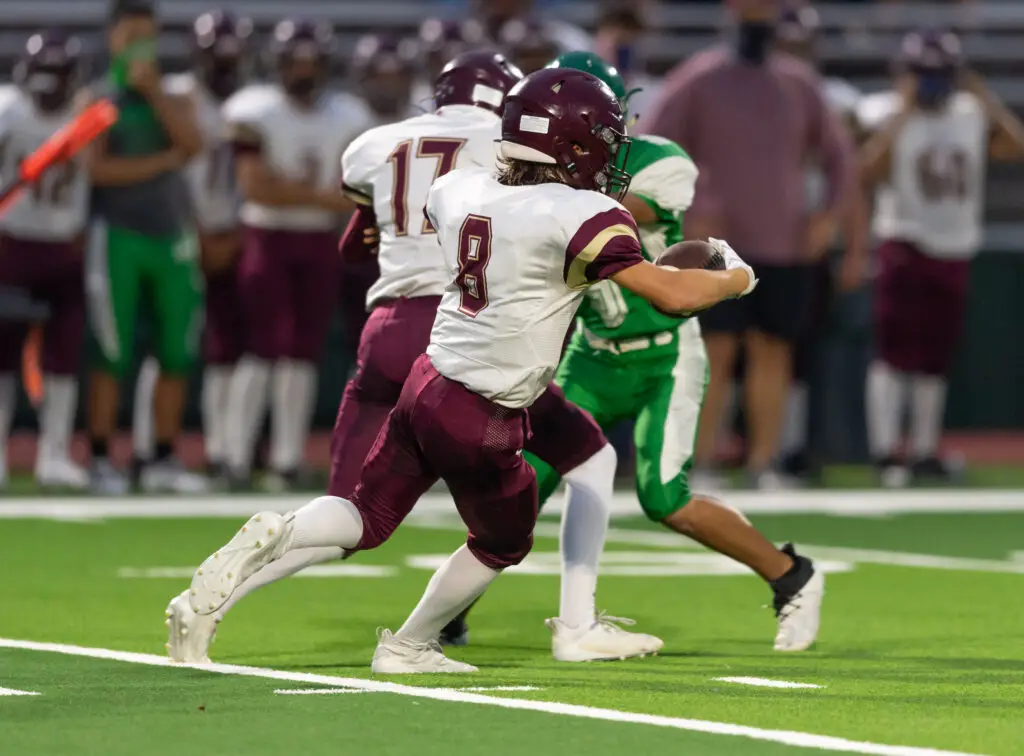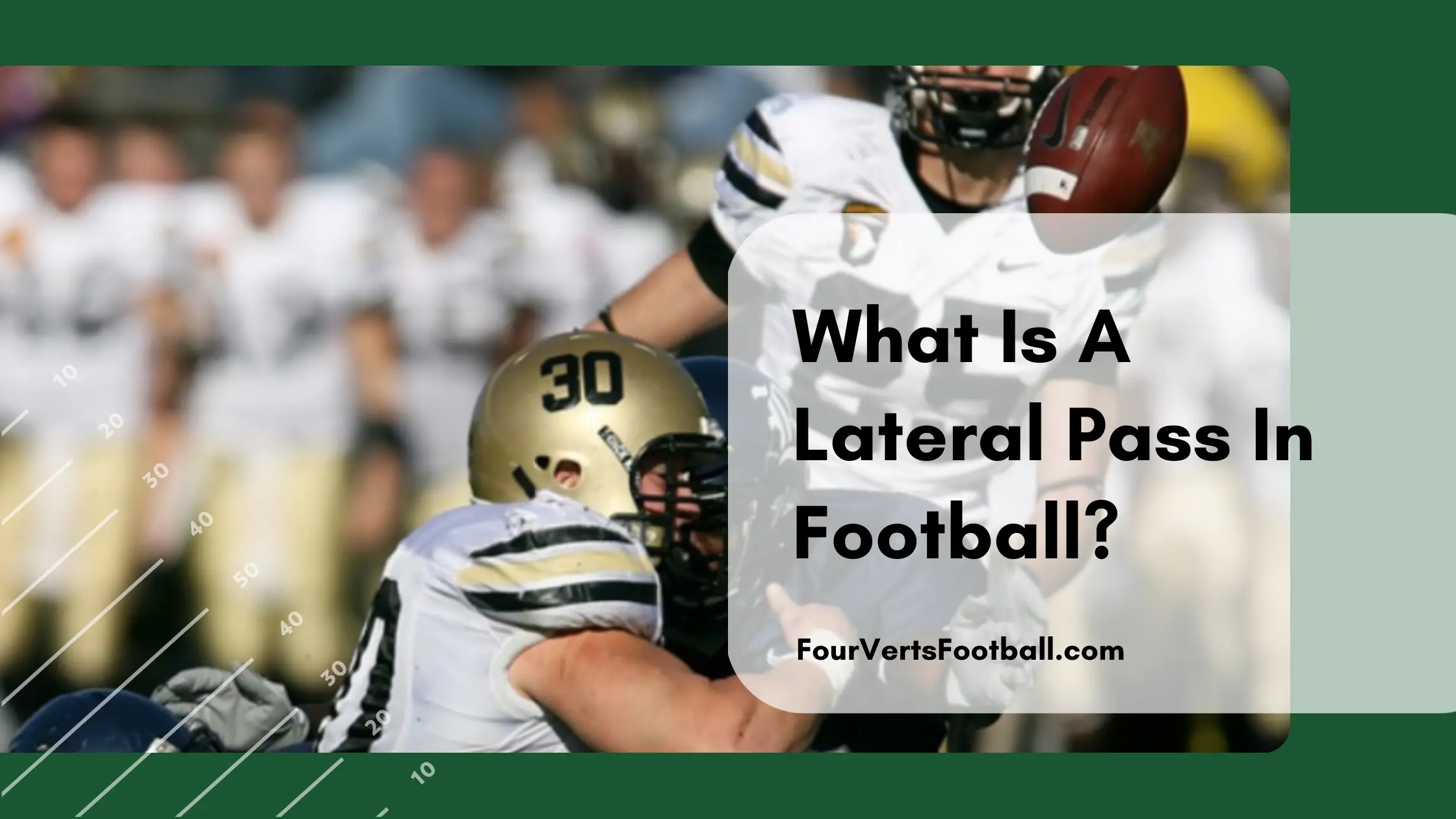A lateral pass in football is a pass that travels backwards from one teammate to another. Lateral passes can be thrown by any player in possession of the ball. Since the ball travels backwards lateral passes are legal and considered a handoff, not a forward pass.
While a lateral pass can be thrown from any location and can be completed by any player on the field.
How many lateral passes are allowed in football?
The beauty of the lateral pass is that you are allowed to attempt as many lateral passes as you wish on a given play. Unlike the forward pass which can only be thrown once per play, the lateral has no limit.
The reasoning for this is simply due to the fact that lateral passes travel backwards. If defenders were forced to cover all receivers for multiple forward passes it would be a nearly impossible task.
While laterals on the other hand have a lower success rate and do not often result in touchdowns.
Is A Lateral A Pass Or Run?
A lateral pass in football is considered a run and not a pass. Though in some circumstances a play can count both of these statistics.
If the only pass that occurs on a play is a lateral. Then all the yards gained on the play will be considered rushing yards. If there is a forward pass with no laterals then all the yards are considered passing yards.
Now say a forward pass is thrown then that player laterals to another player who advances the ball. In this case, the team has gained passing and rushing yards. The passing yards will make up the distance that the receiver who caught the forward pass travelled.
And the rushing yards will count the yards that are gained after the lateral is caught.
How To Do A Lateral Pass
Completing a lateral pass is quite a simple concept as it is very similar to throwing rugby ball. There are two main ways in which football players pass laterals.
The Toss
The most common way to throw a lateral pass is with a rugby-style toss. This throw is quite simple and is done with two hands.
Typically when throwing this pass you place both hands on the bottom half of the ball. You then want to plant one leg and turn at the waist towards the player you wish to throw to.
At this point, you want to swing the ball underhand with both of your arms. The result of this pass is an easy to read lobbed pass that will fall into your teammate’s hands. The passes aren’t too quick but are quite easy to catch.
The Shovel
The other way to throw a lateral pass is with a sort of shovel throwing motion. This throwing motion is typically done with one hand and comes out quicker than a toss. The best way to think of this motion is that you are pushing the ball towards your teammate using the palm of your hand.
This sort of lateral is a little more difficult to catch due to its speed but it will get the ball into your teammate’s hands quicker.
These shovel passes are also used in short forward passing situations when the quarterback is looking to get rid of the ball quickly.

Can A Lateral Pass Hit The Ground
Yes, a lateral pass can hit the ground in football but once it does this ball is live to either team. What we mean by live is that either team that takes grabs the ball will take possession.
When one of these passes hits the ground it is considered a fumble. So the play won’t be blown dead once it hits the ground. But it will open up an opportunity for the other team to take possession of the ball.
Common Plays That Include Laterals
Now that you understand what a lateral is in football it is time to break down which plays tend to use this method.
Hook And Ladder
The hook and ladder is one play in which a team will use a lateral to catch their opponent off guard. As we stated earlier in the article players are able to lateral the ball even if they caught the ball via a forward pass.
On a hook and ladder, the receiver will run a comeback route and catch the ball about ten yards down the field. Another receiver will run a crossing route laterally across the field.
As the second receiver passes the receiver who caught the pass will be given the ball via lateral.
Once the crossing player receives the lateral he will continue to run towards the sideline and then cut upfield.
The defense on this play will move towards the first receiver and will be caught flat-footed when the ball is passed to the second receiver.
This play is quite risky due to a lateral pass being a live ball which is why it is only run in desperate situations.
HB Toss
The half-back toss is another common play in which a backward pass is used. In this play, the running back will be looking to run to the outside.
The fastest way to get the ball to the running back near the sideline is to throw it to him. Since the running back is going to catch the ball behind the line of scrimmage a backwards throw is the easier option.
On this play, the quarterback will toss the ball with both hands in an underhand motion. At this point, no defensive players should be in the backfield which should make this an easy catch for the running back.
The running back will then catch this backward pass and start running downfield.
Lateral passes like this are fairly common on running plays towards the outside of the field. In many cases, these lateral passes will be called pitches of tosses on the broadcast.

